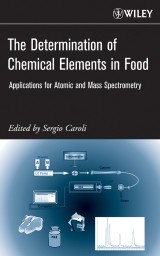Details

The Determination of Chemical Elements in Food
Applications for Atomic and Mass Spectrometry1. Aufl.
|
197,99 € |
|
| Verlag: | Wiley |
| Format: | |
| Veröffentl.: | 31.08.2007 |
| ISBN/EAN: | 9780470140994 |
| Sprache: | englisch |
| Anzahl Seiten: | 752 |
DRM-geschütztes eBook, Sie benötigen z.B. Adobe Digital Editions und eine Adobe ID zum Lesen.
Beschreibungen
<b>State-of-the-art tools and applicationsfor food safety and food science research</b> <p>Atomic spectroscopy and mass spectrometry are important tools for identifying and quantifying trace elements in food products-elements that may be potentially beneficial or potentially toxic. <i>The Determination of Chemical Elements in Food: Applications for Atomic and Mass Spectrometry</i> teaches the reader how to use these advanced technologies for food analysis. With chapters written by internationally renowned scientists, it provides a detailed overview of progress in the field and the latest innovations in instrumentation and techniques, covering:</p> <ul> <li>Fundamentals and method development, selected applications, and speciation analysis</li> <li>Applications of atomic absorption spectrometry, inductively coupled plasma atomic emission spectrometry, and inductively coupled plasma mass spectrometry</li> <li>Applications to foods of animal origin and applications to foods of vegetable origin</li> <li>Foreseeable developments of instrumental spectrometric techniques that can be exploited to better protect consumers' health, with a full account of the most promising trends in spectrometric instrumentation and ancillary apparatuses</li> <li>Applicable laws and regulations at the national and international levels</li> </ul> <p>This is a core reference for scientists in food laboratories in the public andprivate sectors and academia, as well as members of regulatory bodies that deal with food safety.</p>
Preface. <p>Contributors.</p> <p>SECTION 1: FUNDAMENTALS AND METHOD DEVELOPMENT.</p> <p>1. Improvement in Pretreatment and Analysis with Spectrometric Methods: A Typical Application to Routine Analysis.(K. Boutakhrit, F. Bolle, J.M. Degroodt, and L. Goeyens)</p> <p>2. Solubilization: Trends of Development in Analytical Atomic Spectrometry for Elemental Food Analysis. (Henryk Matusiewicz)</p> <p>3. Chemical Elements in Food and the Role of Atomic and Mass Spectrometry. Advantages and Drawbacks of the Determination of Selected Trace Elements in Foodstuffs by Atomic Absorption Spectrometry. (Lars Jorhem and Joakim Engman)</p> <p>4. High-Resolution Continuum Source AAs and its Application to Food Analysis. (Bernhard Welz, Daniel L. G. Borges, and Uwe Heitmann)</p> <p>5. Determining the Geographical Origin of Foods: Considerations when Designing Experimental Protocols and Choosing Analytical Approaches. (John Lewis and Simon Hird)</p> <p>6. Methods Validation for Food Analysis: Concepts and Use of Statistical Techniques. (Joris Van Loco)</p> <p>7. Demonstration of Measurement Capabilities by Means of Interlaboratory Comparison Schemes for Trace Element Analysis in Food. (Yetunde Aregbe, Piotr Robouch, and Thomas Prohaska)</p> <p>SECTION 2: SELECTED APPLICATIONS.</p> <p>8. Applications of Inductively Coupled Plasma Mass Spectrometry to Trace Element research and Control. (Francesco Cubadda)</p> <p>9. Danish Monitoring System for Foods 1998-2003. Content of As, Cd, Hg, Ni, Pb, and Se and Dietary Inake by Children and Adults. (Erik H. Larsen, Inge Rokkjar, and Tue Christensen)</p> <p>10. Trace Elements in the Total Diet Typical of Northern Italy. (M. Bettinelli, S. Spezia, A. Gatti, A. Ronchi, C. Minoia, C. Roggi, and G. Turconi)</p> <p>11. Car Catalytic Converters and the Contamination of Food by Platinum-Group Elements. (Chiara Frazzoli, Roberta Cammarone, and Sergio Caroli)</p> <p>12. Arsenic and Other Potentially Toxic Trace Elements in Rice. (Chiara Frazzoli, Marilena D'Amato, Sergio Caroli, and Gyula Zaray)</p> <p>13. Total Analysis and Distribution of Trace Elements in Human, Cow, and Formula Milk. (Rafael R. de la Flor St. Remy, Maria Luisa Fernandez Sanchez, and Alfredo Sanz-Medel)</p> <p>14. Use of Spectrochemical Methods for the Determination of Metals in Fish and Other Seafood in Louisiana. (Joseph Sneddon)</p> <p>15. Essential and Potentially Toxic Chemical Elements in Beverages.</p> <p> (Patricia Smichowksi and Daniel A. Batistoni)</p> <p>SECTION 3: SPECIATION ANALYSIS.</p> <p>16. Species-Specific Determination of Metal(loid)-containing Food Additive sand Contaminants by Chromatography with ICP-MS Detection. (A. Polatajko, B. Bouyssiere, and J.Szpunar)</p> <p>17. Elemental Speciation in Human Milk and Substitute Food for Newborns. (bernahrd Michalke, Maria Luisa Fernancez Sanchez, and Alfredo Sanz-Medel)</p> <p>18. Measurement of Total Arsenic and Arsenic Species in Seafood By Q ICP-MS. (William A. Maher, Jason Kiry, and Frank Krikowa)</p> <p>19. Sample Preparation Prior to As- and Se-Speciation. (Mihaly Dernovics and Peter Fodor)</p> <p>20. Measurement of Total Se and Se Species in Seafood by Quadrupole Inductively Coupled Plasma Mass Spectrometry, Electrothermal Atomization Atomic Absorption Spectrometry, and High-Performance Liquid Chromatography Inductively Coupled Plasma Mass Spectrometry. (William A. Maher and Frank Kirkowa)</p> <p>21. Application of ICP-MS for the Evaluation of Se Species in Food Related Products and in Dietary Supplements. (Katarzyna Wrobel, Kaximierz Wrobel, and Joseph A. Caruso)</p> <p>22. Determination of Hg Species in Seafood. (Petra Krystek and Rob Ritsema)</p> <p>Author Index.</p> <p>Subject Index. </p>
Sergio Caroli, PHD, is a Research Director at the Department of Foodand Animal Safety, Istituto Superiore di Sanità (National Institute of Health), Rome, and Honorary Professor at the Eötvös Loránd University of Budapest.
<p>State–of–the–art tools and applicationsfor food safety and food science research</p> <p>Atomic spectroscopy and mass spectrometry are important tools for identifying and quantifying trace elements in food products—elements that may be potentially beneficial or potentially toxic. The Determination of Chemical Elements in Food: Applications for Atomic and Mass Spectrometry teaches the reader how to use these advanced technologies for food analysis. With chapters written by internationally renowned scientists, it provides a detailed overview of progress in the field and the latest innovations in instrumentation and techniques, covering:</p> <ul> <li> <p>Fundamentals and method development, selected applications, and speciation analysis</p> </li> <li> <p>Applications of atomic absorption spectrometry, inductively coupled plasma atomic emission spectrometry, and inductively coupled plasma mass spectrometry</p> </li> <li> <p>Applications to foods of animal origin and applications to foods of vegetable origin</p> </li> <li> <p>Foreseeable developments of instrumental spectrometric techniques that can be exploited to better protect consumers' health, with a full account of the most promising trends in spectrometric instrumentation and ancillary apparatuses</p> </li> <li> <p>Applicable laws and regulations at the national and international levels</p> </li> </ul> <p>This is a core reference for scientists in food laboratories in the public andprivate sectors and academia, as well as members of regulatory bodies that deal with food safety.</p>


















